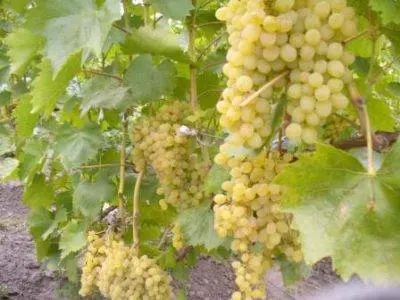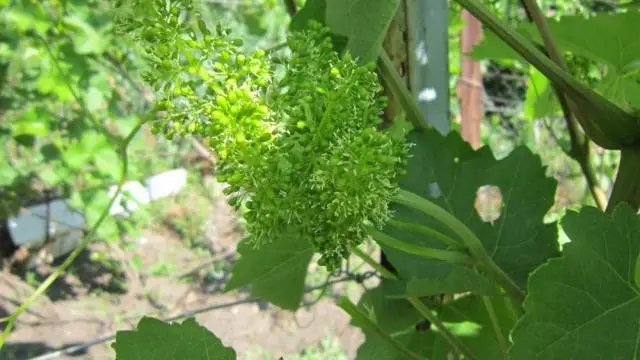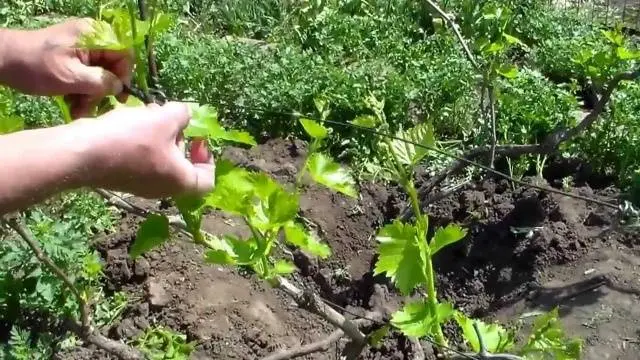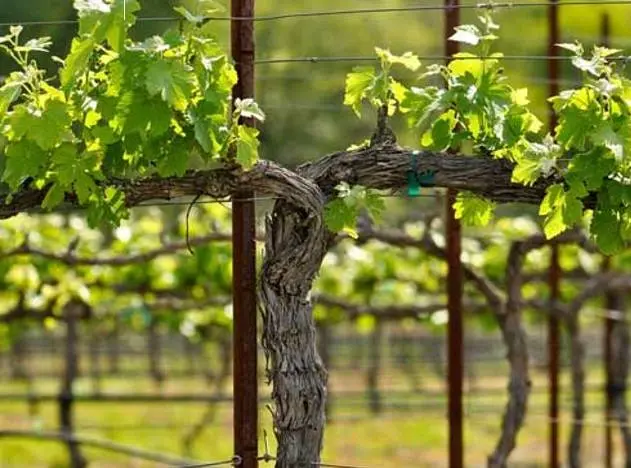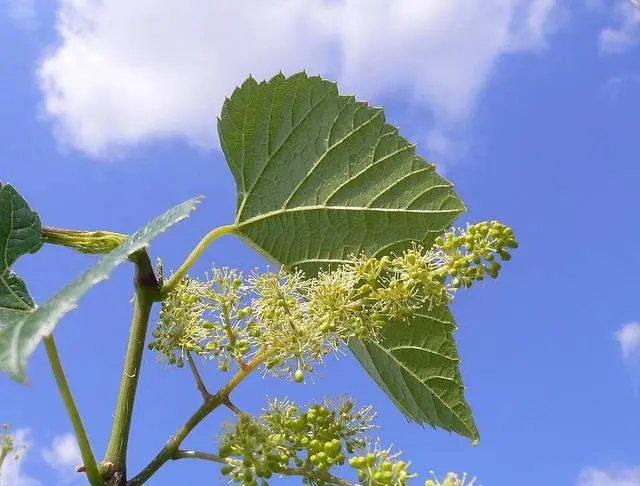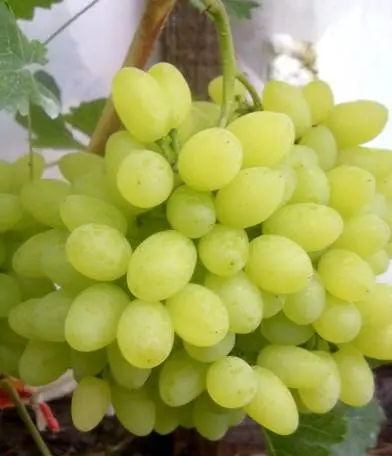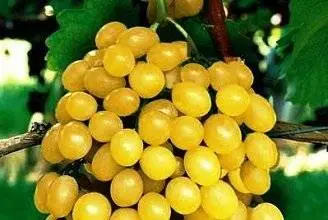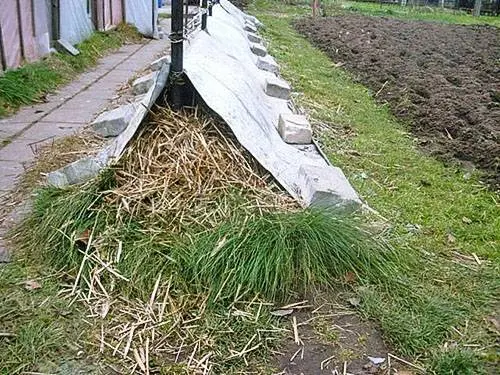Contents
It is no secret that in recent years kishmish grape varieties are becoming increasingly popular among those who want to grow this berry. And this is understandable: such berries are more pleasant to eat, they are not scary to give to children, even the smallest.
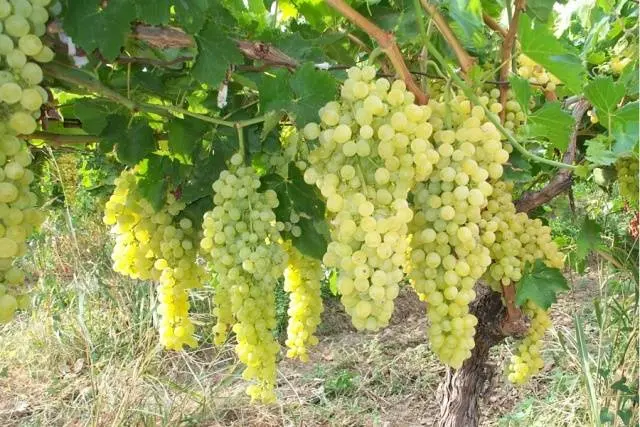
What is kishmish
Quite a lot of sultana varieties of solar berries have been bred. Strictly speaking, those who have no bones at all are literally one. Even the best ones have rudiments of seeds, but they are so small and soft that they are hardly felt when eating.
All raisins are divided into four categories:
- The first and second have either no rudiments or they are barely formed. The size of their berries is small, the weight does not exceed 4 grams.
- In the third and fourth categories, rudiments are present and can be felt when eating. Their berries are much larger, they can weigh up to 9 g.
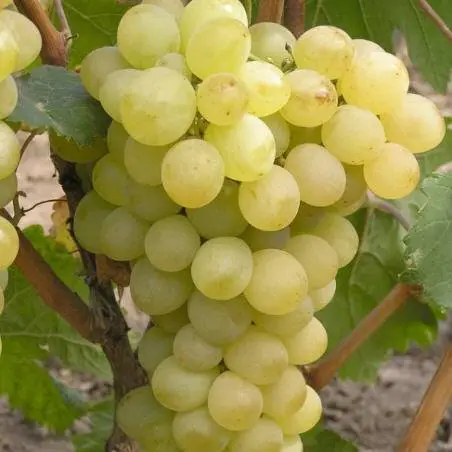
Grapes Rusbol, which is otherwise called Mirage kishmish or Soviet-Bulgarian white kishmish, belongs to the fourth class of seedlessness. This means that there are rudiments in the berry. If you study the reviews of consumers, it turns out that it is currently one of the most popular.
For those who have not yet planted the sultana grape variety Rusbol, we will compile its detailed description and characteristics.
Grape variety Rusbol in the photo.
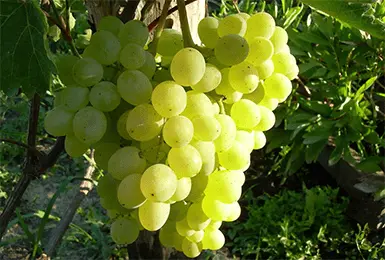
Description and characteristics
Rusbol grapes were created at the All- Research Institute of Viticulture and Winemaking named after Potapenko together with colleagues from Bulgaria, as its name suggests. The parents were: Super early seedless and Villars blanc.
It is not included in the State Register of Breeding Achievements, but, according to winegrowers, it deserves to be grown.
Variety Features
Rusbol grapes have a valuable property for growing in cool regions – an early ripening period: the first berries are ready for picking in 115 days, a cool summer can push this moment up to 125 days.
- Bushes on their own roots first grow medium, and then become tall.

- Vine maturation is early and very good.
- Since the eyes located at the base of the shoot are highly fertile, almost each of them gives a fruitful shoot, which can be cut off, leaving 2-3 eyes, but most often pruning is carried out for 6-8 eyes.
- Flowers appear early, forming a full-bodied ridge. They have a strong aroma that attracts insects, so Rusbol is an excellent pollinator for all other nearby grape bushes.

- Rusbol is prone to crop overload. Rationing of bunches on the shoots is mandatory. If the inflorescence is large, the end can be removed, the berries will be larger and of good presentation. If the yield is too high, the maturation of annual growths is delayed.
- His cuttings are rooting well.
- When planting them in the ground, fruiting is observed already in the second or third year.
- Rusbol is compatible with almost all rootstocks, so any can be used for grafting, but the best result is if you take a tall rootstock.
- It is important to break off part of the shoots with a length of 5 to 10 cm, choosing the weakest ones, the rest will grow better.

- The frost resistance of Rusbol grapes is high – up to -25 degrees, which means that the variety can winter without shelter, provided that the snow cover is at least 50 cm.
- For him, freezing of part of the kidneys is not so scary as for other varieties. If suddenly all the buds freeze on annual growths, perennial wood will give new ones, and high fruitfulness will not allow you to be left without a crop. As a rule, Rusbol is covered only in the first three years of life, during which time it accumulates perennial wood. Winter hardiness of buds on perennial wood exceeds that on annual shoots by 6-8 degrees.

- Resistance to major grape diseases is high.
- Rusbol in the south can be grown in a high-stem culture, to the north it is formed on a low stem, leaving sleeves of medium length. It also gives a good harvest with short-sleeved shaping.
- Clusters are large, on average – from 400 to 600 g, but with good care they can weigh a kilogram or more.
- They have a conical shape, their friability is medium.
Rusbol Berries
For kishmish grapes, they have a very large size: 16 mm wide, 18 mm long.
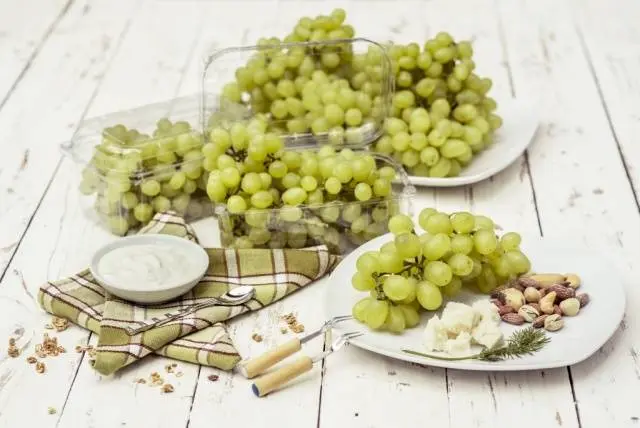
- The color of the berries is white, they contain rudiments.
- The taste is simple and harmonious.
- Sugar accumulation is high – up to 21%, acid content up to 7 g / l.
- Rusbol can be used as a table grape, it is also well suited for processing into raisins.
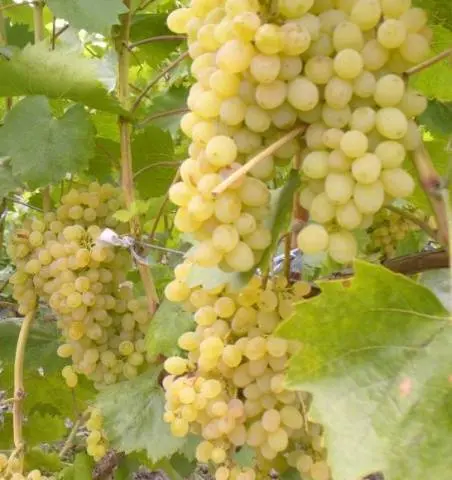
The originators of the Rusbol variety recommended it for cultivation as a non-covering crop for the Moscow region and more northern regions.
There is nothing in the world that cannot be improved. This is exactly what the staff of the Potapenko Institute did and crossed Rusbol grapes with two other varieties: Delight and Villars Blanc. The result of the selection was Rusball improved. We will compose its description and give a complete description. Photo of Rusbol improved grapes.
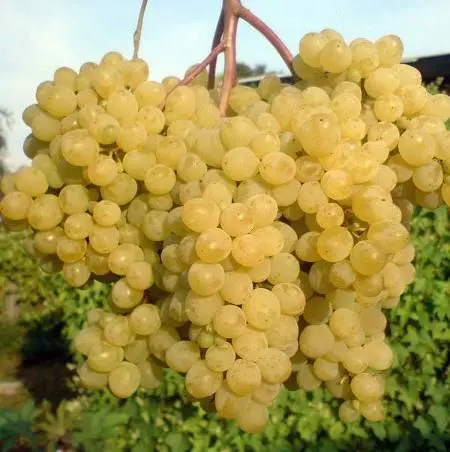
What is good Rusball improved
Taking all the best from his parents, he acquired new undeniable virtues.
- The ripening period has become earlier – from 105 to 115 days.
- Improved Rusbol bush has a great growth force.
- Annual growths ripen well and cuttings take root.
- Rusball improved is compatible with almost all rootstocks.
- This grape variety can produce berries in the second year after planting.
- The fruitfulness of the kidneys of Rusbol improved is high – from 75 to 95%.
- Just like its parent, it can be overloaded with crops, so it needs to be rationed.

- Its frost resistance is no worse than that of the original forms – up to -25 degrees.
- Improved Rusbol grapes respond well to care.
- It is resistant to major diseases affecting grape crops.
- The clusters of Rusbol improved have become larger. Their average weight is from 700 to 900 g, and with good care, one bunch can produce more than one and a half kilograms of berries.
- The berries themselves also became larger: their length is 20 mm, and their width is 16 mm.

- They are round or oval, sometimes like an egg.
- Rudiments may be present in the berries, since the variety belongs to the third – fourth class of seedlessness.
- The color of the berries of Rusbol improved is white, where the sun warms more, the berries have a brown tan.
- The pulp of this grape variety is dense, harmonious taste. Sugar accumulation is good.
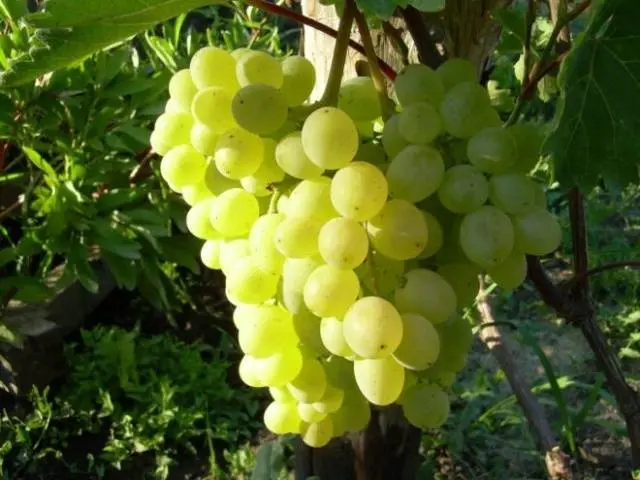
Rusbol nutmeg – special sultanas
There is another grape variety based on Rusbol. This is Rusball Muscat. Its authors are the same, they became parents: Bulgaria is stable and Rusbol. The description and characteristics will reveal all the possibilities of the Muscat Rusbol variety, which is shown in the photo.
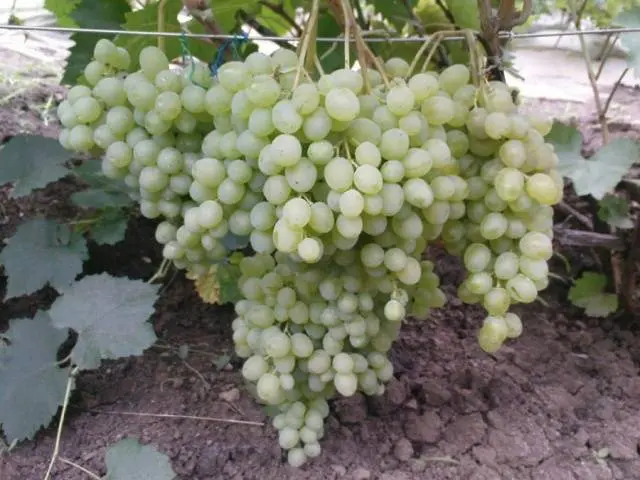
He had a nutmeg taste so appreciated by many. Berries are better stored than other Rusbols, they can turn into raisins even at room conditions. Rusbol Muscat also has all the main advantages of this group of varieties.
- He is early maturing. The berries ripen in about 120 days. There may be fluctuations in either direction for 5 days.
- The strength of the Rusbol Muscat grapes is medium or high, if it is not grafted, but a rooted seedling.
- One-year growth matures well. If the bush is overloaded with a crop, especially in rainy weather, the maturation of one-year growth slows down.
- The percentage of fruitfulness of shoots is somewhat lower than that of the original variety, but still remains high – from 75 to 85%.
- The vine is cut at Rusbol Muscat for 6-8 eyes. Short pruning is also possible – only 3-4 eyes.

- The grape variety Rusbol Muscat is better if it is grafted onto a vigorous rootstock.
- The frost resistance of the variety is good – 24 degrees.
- Rusbol Muscat grapes are resistant to mildew, and treatments are required from oidium, since resistance to it is weak.
- The weight of each bunch of this grape variety is from 400 g to 0,5 kg. They are moderately loose, can be cylindrical or branched.

- The variety belongs to the 4th category of seedlessness, that is, there are rudiments of seeds in the berries.
Care of grapes
Agricultural technology for all Rusbols is the same as for any other table grape variety:
- Timely and plentiful watering.
- Timely and properly carried out top dressing. This is especially important for the Rusbol improved grape variety.
- Mandatory rationing of the crop, and breaking out excess shoots.
- Forming pruning in autumn and during summer.
- For the first three years, it is advisable to cover Rusbol grape varieties.
How to hide
This grape is usually referred to as non-covering varieties. But if winters are snowless, there is always a risk that young bushes that have not yet grown enough perennial wood may lose a large number of eyes. It will take a long time to restore them. Therefore, it is better not to risk it, and cover the grapes for the first 3 years for the winter.

Shelter Algorithm
Shelter times depend on weather conditions. It is impossible to warm the grapes too early – the eyes can spit out. Covering too late may damage the roots.
- After the autumn pruning of grapes, it takes some time to prepare them for winter. Therefore, it is not worth rushing to shelter at the first frost. Hardening of grapes takes place within a week at temperatures from zero to -5 degrees.
- Since the roots of the Rusbol grape are more sensitive to frost than the shoots, the shelter begins with warming the root zone. To do this, it is mulched with a layer of humus about 10 cm thick.
- Trimmed vines are tied into bundles, bent to the ground and laid on any material that does not allow moisture to pass through: plastic, wood, roofing material, rubber sheets.

- The soil and shoots are to be treated with a solution of iron sulphate according to the instructions.
- Then you can proceed in different ways. Many growers cover the shoots with earth. This shelter is quite reliable, but there is always a risk of moisture dampening of the eyes. If you cover the ground with moisture-proof material, it will be much smaller.
- The best option is a dry-air shelter. The laid vine is covered with dry leaves or covered with spruce branches. Cover with spunbond, and on top with a film thrown over the arcs, leaving holes at the base for ventilation. To prevent the film from being blown away by the wind, it is fixed.

Reviews
Conclusion
Any of the Rusbols is worthy of growing on a garden plot. These varieties will not only provide high-quality table berries, but will also allow you to prepare raisins for the winter, which, given their high cost, is important.










